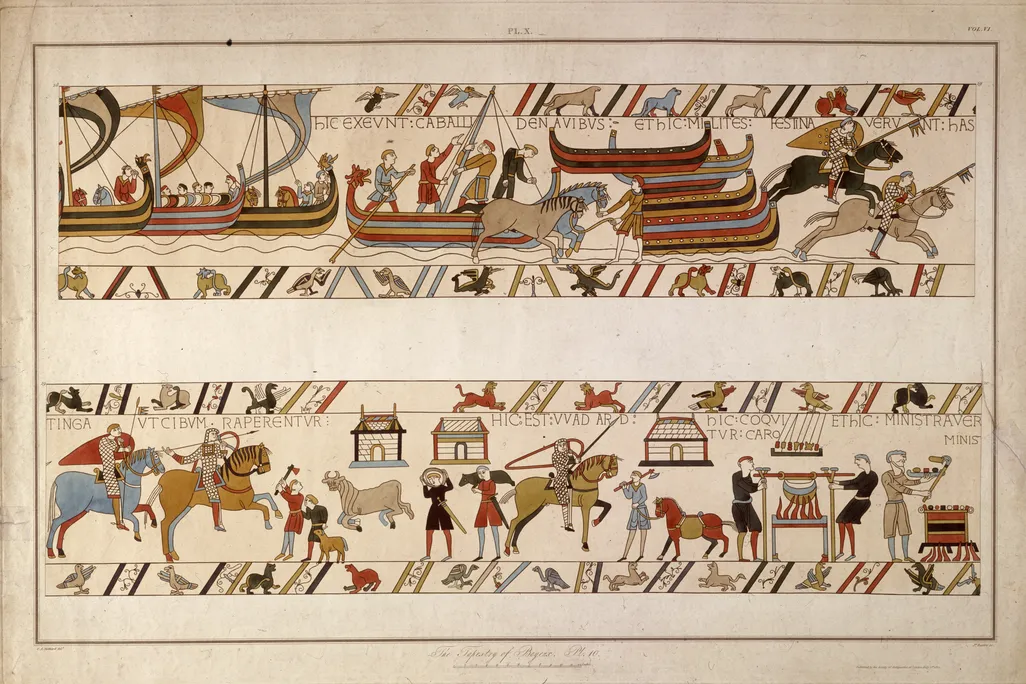The 230-Foot-Long Bayeux Tapestry Is Returning Home to England for the First Time in Nearly 1,000 Years
The tapestry, which depicts the Norman conquest of England, will be on display at the British Museum in 2026. Officials have been trying to arrange the loan for decades

The 11th-century Bayeux Tapestry, which details the Norman conquest of England, is returning home to Britain for the first time in nearly 1,000 years. It has been in France since 1077.
France will loan the 230-foot-long embroidered textile to the British Museum, where it will be exhibited from September 2026 to July 2027. Officials announced the agreement on July 8 during French President Emmanuel Macron’s state visit to the United Kingdom.
“For the first time in 900 years the Bayeux tapestry will follow the same path as the warriors whose stories it tells and land on British soil,” Macron explained at a recent state banquet held at Windsor Castle, per the Guardian’s Nadia Khomami and Morgan Ofori.
The tapestry depicts the 1066 Norman invasion and the Battle of Hastings, in which William, Duke of Normandy (known as “William the Conqueror”) defeated the English king Harold Godwinson to become the first Norman ruler of England. The Normans ruled England until 1154, just shy of 100 years.
Fun fact: Recent discoveries about the Bayeux Tapestry
Earlier this year, researchers announced they’d discovered a lost fragment of the tapestry in the state archives of Schleswig-Holstein in Germany.
Experts think the tapestry was created by nuns in Canterbury, England, at the behest of William’s half-brother Bishop Odo of Bayeux and taken to France in the years after William won the English throne. It was then hung around the nave of the Bayeux Cathedral in Normandy. In 950 years, it has only been moved on a few occasions, including a brief stint during World War II. It has been on display at the Bayeux Museum in Normandy since 1983.
“The Bayeux Tapestry is one of the most important and unique cultural artifacts in the world, which illustrates the deep ties between Britain and France and has fascinated people across geographies and generations,” Nicholas Cullinan, director of the British Museum, says in a statement. “This will be the first time the Bayeux Tapestry has been in the U.K. since it was made, almost 1,000 years ago.”
The tapestry features 58 scenes, 626 characters and 202 horses embroidered on linen with wool thread. They provide an in-depth look at what life was like in medieval Normandy and England, including details on the Vikings’ seafaring traditions and military structures.
/https://tf-cmsv2-smithsonianmag-media.s3.amazonaws.com/filer_public/4f/db/4fdb9104-7b9f-4287-87c8-7bc0ca2f8592/gettyimages-1167780037.jpg)
“There is no other single item in British history that is so familiar, so studied in schools, so copied in art as the Bayeux Tapestry,” George Osborne, chair of the British Museum Trustees, says in the statement.
Britain has been attempting to arrange a loan since 1953, when officials tried to secure an agreement in celebration of Elizabeth II’s coronation. However, France suddenly reversed course before the deal was finalized. Macron agreed to loan the tapestry in 2018, but officials ultimately declared it too fragile to be moved.
“The fact that this loan has actually been brokered is just a monumental kind of collaborative effort in terms of sharing this cross-cultural legacy,” Andrew Saluti, a scholar of museum studies at Syracuse University, tells the New York Times’ Jonathan Wolfe and Sopan Deb.
In exchange, Britain will loan France various early medieval and Viking treasures from all four nations of the U.K., including 12th-century ivory chessmen and artifacts from Sutton Hoo, the seventh-century royal ship burial in Suffolk, England.
/https://tf-cmsv2-smithsonianmag-media.s3.amazonaws.com/accounts/headshot/asia.png)
